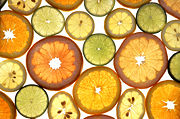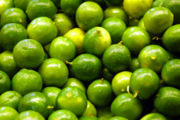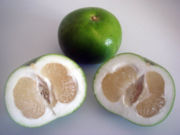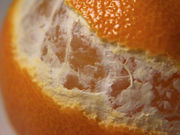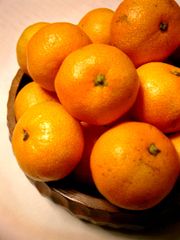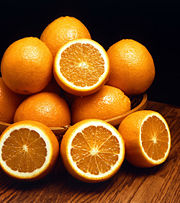Citrus
2008/9 Schools Wikipedia Selection. Related subjects: Food; Plants
| Citrus | ||||||||||||||||||||
|---|---|---|---|---|---|---|---|---|---|---|---|---|---|---|---|---|---|---|---|---|
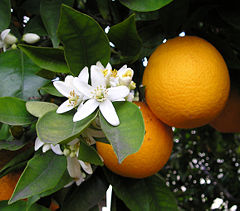 Mandarin Orange (Citrus reticulata cultivar)
|
||||||||||||||||||||
| Scientific classification | ||||||||||||||||||||
|
||||||||||||||||||||
| Species and hybrids | ||||||||||||||||||||
|
Important species:
Important hybrids:
See also below for other species and hybrids. |
||||||||||||||||||||
| Synonyms | ||||||||||||||||||||
|
Eremocitrus |
Citrus is a common term and genus of flowering plants in the family Rutaceae, originating in tropical and subtropical southeast Asia. The Latin word citrus was borrowed from ancient Greek kedros "cedar, juniper" probably through Etruscan. The Romans applied the word to several different trees with fragrant foliage or wood (compare the completely unrelated cedars). The taxonomy and systematics of the genus are complex and the precise number of natural species is unclear, as many of the named species are clonally-propagated hybrids, and there is genetic evidence that even some wild, true-breeding species are of hybrid origin. Cultivated Citrus may be derived from as few as four ancestral species. Natural and cultivated origin hybrids include commercially important fruit such as the oranges, grapefruit, lemons, some limes, and some tangerines.
Recent research has suggested that the closely related genus Fortunella (kumquats), and perhaps also Poncirus and the Australian Microcitrus and Eremocitrus, should be included in Citrus. In fact, most botanists now classify Microcitrus and Eremocitrus as part of the genus Citrus.
Description
These plants are large shrubs or small trees, reaching 5–15 m tall, with spiny shoots and alternately arranged evergreen leaves with an entire margin. The flowers are solitary or in small corymbs, each flower 2–4 cm diameter, with five (rarely four) white petals and numerous stamens; they are often very strongly scented. The fruit is a hesperidium, a specialised berry, globose to elongated, 4–30 cm long and 4–20 cm diameter, with a leathery rind surrounding segments or "liths" filled with pulp vesicles. The genus is commercially important as many species are cultivated for their fruit, which is eaten fresh, pressed for juice, or preserved in marmalades.
Citrus fruits are notable for their fragrance, partly due to flavonoids and limonoids (which in turn are terpenes) contained in the rind, and most are juice-laden. The juice contains a high quantity of citric acid giving them their characteristic sharp flavour. They are also good sources of vitamin C and flavonoids.
Cultivation
Citrus trees hybridise very readily - depending on the pollen source, plants grown from a Persian Lime's seeds can produce fruit similar to grapefruit. Thus all commercial citrus cultivation uses trees produced by grafting the desired fruiting cultivars onto rootstocks selected for disease resistance and hardiness.
The colour of citrus fruits only develops in climates with a ( diurnal) cool winter. In tropical regions with no winter, citrus fruits remain green until maturity, hence the tropical "green oranges". The Persian Lime in particular is extremely sensitive to cool conditions, thus it is usually never exposed to cool enough conditions to develop a mature colour. If they are left in a cool place over winter, the fruits will actually change to a yellow colour. Many citrus fruits are picked while still green, and ripened while in transit to supermarkets.
Citrus trees are not generally frost hardy. Mandarin Oranges (C. reticulata) tend to be the hardiest of the common Citrus species and can withstand short periods down to as cold as −10 °C, but realistically temperatures not falling below −2 °C are required for successful cultivation. Tangerines, tangors and yuzu can be grown outside even in regions with more marked sub-zero degrees in winter, although this may affect fruit quality. A few hardy hybrids can withstand temperatures well below freezing, but do not produce quality fruit. Lemons can be commercially grown in cooler-summer/moderate-winter coastal Southern California, because sweetness is neither attained nor expected in retail lemon fruit. The related Trifoliate Orange (Poncirus trifoliata) can survive below −20 °C; its fruit are astringent and inedible unless cooked but a few better-tasting cultivars and hybrids have been developed (see citranges).
The trees do best in a consistently sunny, humid environment with fertile soil and adequate rainfall or irrigation. Older 'abandoned' Citrus in low valleyland may suffer, yet survive, the dry summer of Central California's Inner Coast Ranges. At any age Citrus grows well enough with infrequent irrigation in partial/understory shade, but the fruit crop is smaller. Though broadleaved, they are evergreen and do not drop leaves except when stressed. The stems of many varieties have large sharp thorns. The trees flower in the spring, and fruit is set shortly afterward. Fruit begins to ripen in fall or early winter months, depending on cultivar, and develops increasing sweetness afterward. Some cultivars of tangerines ripen by winter. Some, such as the grapefruit, may take up to eighteen months to ripen.
Major commercial citrus growing areas include southern China, the Mediterranean Basin (including southern Spain), South Africa, Australia, the southernmost United States, and parts of South America. In the U.S., Florida, California, Arizona, and Texas are major producers, while smaller plantings are present in other Sun Belt states.
As ornamental plants
Citrus trees grown in tubs and wintered under cover were a feature of Renaissance gardens, once glass-making technology enabled sufficient expanses of clear glass to be produced. An orangery was a feature of royal and aristocratic residences through the 17th and 18th centuries. The Orangerie at the Palace of the Louvre, 1617, inspired imitations that were not eclipsed until the development of the modern greenhouse in the 1840s. In the United States the earliest surviving orangery is at the Tayloe House, Mount Airy, Virginia. George Washington had an orangery at Mount Vernon.
Some modern hobbyists still grow dwarf citrus in containers or greenhouses in areas where it is too cold to grow it outdoors. Consistent climate, sufficient sunlight, and proper watering are crucial if the trees are to thrive and produce fruit. Compared to many of the usual "green shrubs", citrus trees better tolerate poor container care. For cooler winter areas, limes and lemons should not be grown, since they are more sensitive to winter cold than other citrus fruits. Hybrids with kumquats (× Citrofortunella) have good cold resistance.
Pests and diseases
Citrus plants are very liable to infestation by aphids, whitefly and scale insects (e.g. California red scale). Also rather important are the viral infections to which some of these ectoparasites serve as vectors such as the aphid-transmitted Citrus tristeza virus which when unchecked by proper methods of control is devastating to citrine plantations.
European brown snails ( Helix aspersa) can be a problem in California, though laying female Khaki Campbell and other Mallard-based ducks can be used for control.
The foliage is also used as a food plant by the larvae of Lepidoptera ( butterfly and moth) species such as the Geometridae Hemithea aestivaria ( Common Emerald) and Gymnoscelis rufifasciata ( Double-striped Pug), or the Arctiidae Hypercompe scribonia ( Giant Leopard Moth), H. eridanus, H. icasia and H. indecisa.
Production
| Top Ten Citrus Producers — 2005 | ||||
|---|---|---|---|---|
| Country | Production (Int $1000) | Footnote | Production (MT) | Footnote |
| 1,167,400 | C | 3,250,000 | F | |
| 387,936 | C | 1,135,000 | F | |
| 75,432 | C | 210,000 | F | |
| 71,840 | C | 200,000 | F | |
| 64,656 | C | 180,000 | F | |
| 50,288 | C | 140,000 | F | |
| 46,696 | C | 130,000 | F | |
| 31,610 | C | 88,000 | F | |
| 30,532 | C | 85,000 | F | |
| 28,018 | C | 78,000 | F | |
| No symbol = official figure,F = FAO estimate, * = Unofficial figure, C = Calculated figure; Production in Int $1000 have been calculated based on 1999-2001 international prices |
||||
Uses
Culinary
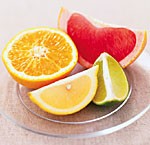
Many citrus fruits, such as oranges, tangerines, grapefruits, and clementines, are generally eaten fresh. They are typically peeled and can be easily split into segments. Grapefruit is more commonly halved and eaten out of the skin with a spoon. There are special spoons ( grapefruit spoons) with serrated tips designed for this purpose. Orange and grapefruit juices are also very popular breakfast beverages. More astringent citrus, such as lemons and limes are generally not eaten on their own. Meyer Lemons can be eaten 'out of hand' with the fragant skin; they are both sweet and sour. Lemonade or limeade are popular beverages prepared by diluting the juices of these fruits and adding sugar. Lemons and limes are also used as garnishes or in cooked dishes. Their juice is used as an ingredient in a variety of dishes; it can commonly be found in salad dressings and squeezed over cooked meat or vegetables. A variety of flavours can be derived from different parts and treatments of citrus fruits. The rind and oil of the fruit is generally very bitter, especially when cooked. The fruit pulp can vary from sweet and tart to extremely sour. Marmalade, a condiment derived from cooked orange and lemon, can be especially bitter. Lemon or lime is commonly used as a garnish for water, soft drinks, or cocktails. Citrus juices, rinds, or slices are used in a variety of mixed drinks. The colourful outer skin of some citrus fruits, known as zest, is used as a flavouring in cooking; the white inner portion of the peel, the pith, is usually avoided due to its bitterness. The zest of a citrus fruit, typically lemon or an orange, can also be soaked in water in a coffee filter, and drunk.
Medical
Citrus juice also has medical uses; lemon juice is used to relieve the pain of bee stings. The orange is also used in vitamin C pills, which prevents scurvy. Scurvy is caused by vitamin C deficiency, and can be prevented by having 10 milligrams of vitamin C a day. An early sign of scurvy is fatigue. If ignored, later symptoms are bleeding and bruising easily. After consumption, the peel is sometimes used as a facial cleanser. Before the development of fermentation-based processes, lemons were the primary commercial source of citric acid.
List of citrus fruits
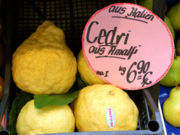

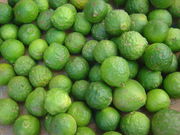
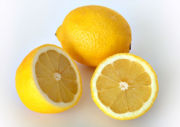
The genus Citrus has been suggested to originate in Southeast Asia. Prior to human cultivation, it consisted of just a few species:
- Papedas
- Australian limes
- Citrus australasica – Finger Lime - sometimes separated in Microcitrus
- Citrus australis – Australian Round Lime - sometimes separated in Microcitrus
- Citrus glauca – Desert Lime - sometimes separated in Eremocitrus
- and 3 other Microcitrus
Hybrids and cultivars
Sorted by parentage. As each is the product of (at least) two parent species, they are listed mutliple times.
- Citrus maxima-based
- Amanatsu, natsumikan – Citrus × natsudaidai (C. maxima × unknown)
- limequat
- fortunella margareta
- Grapefruit, Citrus × paradisi (C. maxima × C. × sinensis)
- Imperial Lemon (C. × limon × C. × paradisi)
- Minneola Tangelo (C. reticulata × C. × paradisi)
- Orangelo, Chironja (C. × paradisi × C. × sinensis)
- Oroblanco, Sweetie (C. maxima × C. × paradisi)
- Sweet Orange – Citrus × sinensis (probably C. maxima × C. × reticulata)
- Tangelo – Citrus × tangelo (C. reticulata × C. maxima or C. × paradisi)
- Tangor – Citrus × nobilis (C. reticulata × C. × sinensis)
- Ugli (C. reticulata × C. maxima or C. × paradisi)
- Wilking (C. × nobilis × C. × deliciosa)
- Citrus medica-based
- Buddha's Hand – Citrus medica var. sarcodactylus
- Etrog
- Fernandina – Citrus × limonimedica (probably C. medica × C. × limon)
- Ponderosa Lemon (probably C. medica × C. × limon)
- Citrus reticulata-based
- Bergamot Orange, Seville Orange – Citrus × aurantium ssp. bergamia or Citrus × bergamia
- Bitter Orange – Citrus × aurantium
- Blood Orange – Citrus × sinensis cultivars
- Cam sành (C. reticulata × C. × sinensis)
- Chinotto – Citrus × aurantium var. myrtifolia or Citrus × myrtifolia
- ChungGyun
- Clementine – Citrus × clementina
- Cleopatra Mandarin – Citrus × reshni
- Dekopon – Citrus reticulata cv. 'Siranui' (Kiyomi × Ponkan)
- Daidai – Citrus × aurantium var. daidai or Citrus × daidai
- Grapefruit, Citrus × paradisi (C. maxima × C. × sinensis)
- Hermandina
- Imperial Lemon (C. × limon × C. × paradisi)
- Kinnow
- Meyer Lemon, Valley Lemon – Citrus × meyeri (C. × limon × C. × paradisi or C. × sinensis)
- Michal Mandarin
- Mikan, satsuma – Citrus × unshiu
- Minneola Tangelo (C. reticulata × C. × paradisi)
- Nova Mandarin
- Orangelo, Chironja (C. × paradisi × C. × sinensis)
- Oroblanco, Sweetie (C. maxima × C. × paradisi)
- Ponkan
- Rangpur, Lemanderin, Mandarin Lime – Citrus × limonia (C. reticulata × C. × limon)
- Sweet Orange – Citrus × sinensis (probably C. maxima × C. × reticulata)
- Tangelo – Citrus × tangelo (C. reticulata × C. maxima or C. × paradisi)
- Tangerine
- Tangor – Citrus × nobilis (C. reticulata × C. × sinensis)
- Ugli (C. reticulata × C. maxima or C. × paradisi)
- Wilking (C. × nobilis × C. × deliciosa)
- Willow Leaf – Citrus × deliciosa
- Yuzu – Citrus × junos (C. reticulata × C. × ichangensis)
- Unresolved
- Alemow, Colo – Citrus × macrophylla
- Djeruk limau – Citrus × amblycarpa
- Gajanimma, Carabao Lime – Citrus × pennivesiculata
- Ichang Lemon, Ichang papeda – Citrus × ichangensis
- Imperial Lemon (C. × limon × C. × paradisi)
- Iyokan, anadomikan
- Kabosu – Citrus × sphaerocarpa
- Kaffir Lime, makrut – Citrus × hystrix
- Khasi Papeda – Citrus × latipes
- Lemon – Citrus × limon
- Limetta, Sweet Lemon, Sweet Lime, mosambi – Citrus × limetta
- Omani Lime
- Palestine Sweet Lime – Citrus × limettioides
- Persian lime, Tahiti Lime – Citrus × latifolia
- Rough Lemon – Citrus × jambhiri
- Shekwasha, Hirami Lemon, Taiwan Tangerine – Citrus × depressa
- Sudachi – Citrus × sudachi
- Sunki, Suenkat – Citrus × sunki
- Tachibana Orange
- Volkamer Lemon – Citrus × volkameriana
For hybrids with kumquats, see × Citrofortunella. For hybrids with the Trifoliate Orange, see citrange.
